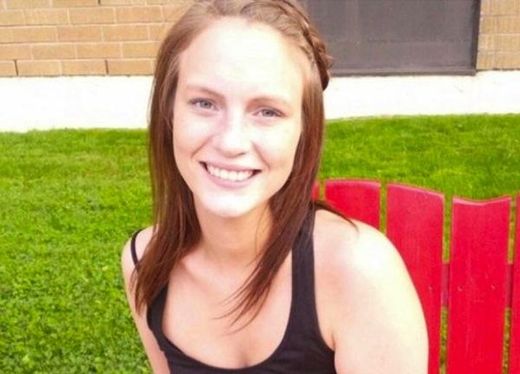
Loretta Saunders, 26, was last seen alive on February 13, according to news accounts. Surveillance cameras filmed her as she left her apartment building, where she had gone to collect rent from her subletters, police told the National Post. Over the next few days, family members received odd text messages from her phone. Then silence. Concerned, especially when one of the messages asked for information about accessing her bank account, the family reported her missing on February 17. Saunders's car was found in Ontario, near Michigan, on February 18 in the possession of her roommates, who were arrested and charged with fraud and possession of stolen goods. Police also discovered outstanding warrants for their arrest elsewhere in the country.
Then on Wednesday February 26 the pregnant Saunders's body was "found on a median off Route 2 of the Trans-Canada Highway in New Brunswick," the National Post reported. It was hundreds of miles from where she lived and was last seen.
Blake Leggette, 25, and 28-year-old Victoria Henneberry were arrested near Windsor, Ontario, 2,000 miles away and brought back to Nova Scotia to face the charges in Halifax. Police said they are treating Saunders's death as a homicide but did not immediately reveal whether more charges were pending. Saunders had left her boyfriend's apartment on the day of her disappearance to meet with them and collect back rent, The Globe and Mail said.
Saunders attended Saint Mary's University and was studying criminology. She hailed from Nunatsiavut, the Inuit territory of Newfoundland and Labrador, where she was one of eight siblings in a close-knit family, according to The Globe and Mail. The very nature of her research told her family there was something wrong.
"She is a proud Inuk whose thesis topic is on missing and murdered aboriginal women in Canada, so she knows better than to just disappear like this," said her sister, Delilah Terriak, in a Facebook message quoted by the National Post before Saunders's body was found.
Saunders was described as passionately devoted to understanding the issues surrounding the disappearances and murders of aboriginal women. Her thesis advisor, Darryl Leroux, said he was inspired by the inquisitive young student from the first time she attended his class and was struck by the depth of her commitment. When the search for her was still active, Leroux wrote eloquently about his student for Halifax Media Coop.
"The last time I met with Loretta Saunders, two weeks ago, I had never felt more inspired and proud of a student," he wrote on February 20, recounting a thesis proposal that at 28 pages and 11,000 words was three times the department requirements for honors students.
"Beyond its remarkable length, Loretta carefully presented her research in what I recognized as the most beautifully written and cared-for assignment I had ever read in seven years of university teaching, evaluating literally thousands of assignments," Leroux wrote, adding that he was "buoyed by her rigorous writing and research."
He was equally inspired by her dedication to the topic and unflinching scrutiny of the issues as she delved into the cases of three women in particular.
"Loretta's research broaches a topic that is largely taboo in Canadian society: the heartbreaking phenomenon of missing and murdered indigenous women," recounted Leroux, who teaches sociology and criminology in K'jipuktuk, Sikep'nekatik district, Mi'kma'ki.
"In an act of courage that still moves me deeply, Loretta refused to turn away from the traumatic nature of this violence; she chose instead to invest all of her energy in a healing journey that would benefit indigenous youth in her home territory and in indigenous communities and territories wherever they encountered her," Leroux wrote. "It was both a deeply personal journey, and one filled with intellectual curiosity. Above all, during our last meeting, Loretta articulated her firm commitment to share her work and experiences with an open, genuine, and loving heart."
Several family members were already in Halifax helping in the search and plastering the city with more than 2,000 posters, The Globe and Mail reported. When Saunders's body was found, Cheryl Maloney, president of the Nova Scotia Native Women's Association and acting as a spokesperson for the family, said that Nova Scotians and the city of Halifax "all fell in love with this girl," according to The Globe and Mail. She noted that Saunders, though indigenous, fell far outside the stereotypes - and yet it was not enough to protect her.
"She wasn't what society expected for a missing aboriginal girl. Canadian society, and especially our prime minister, has been able to ignore the reality of the statistics that are against aboriginal girls," Maloney said, according to CBC News. "This is not what everyone expects, but she is at risk. Every aboriginal girl in this country is vulnerable."
Maloney called again for a national inquiry into the issue of missing and murdered aboriginal women.
"For Canada to be ignoring it for so long, it's disheartening," she said. "How many more families does this have to happen to before they take seriously the problem?"



More than anything else, the university (colleges), the 'higher education' system, whether it be in the US, Canada or anywhere else in the world, teaches obedience to, deference toward and participation in, psychopathy.
The lengthy studies students make and are given and all the paperwork they write and do, are all part of deep indoctrination process that begins in childhood.
The various -isms, including feminism, are all part of this. All of the so-called advanced studies are part of this....
This poor unfortunate Inuit woman, probably had no clue.
And still, neither do many of you, although Sott is or seems to me, to be pretty good at uncovering (through discussion) the vast webwork of the psychopathic mind. At least in comparison to many other of these types of public forum and news and informations sites. Obviously, no censorship of discussion is part of the uncovering.
ned